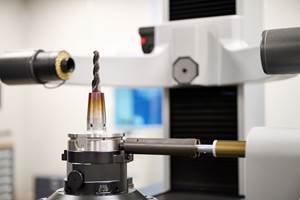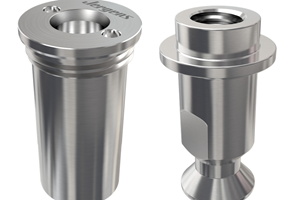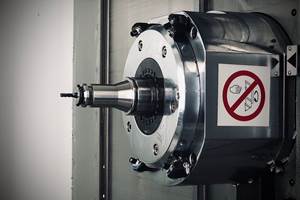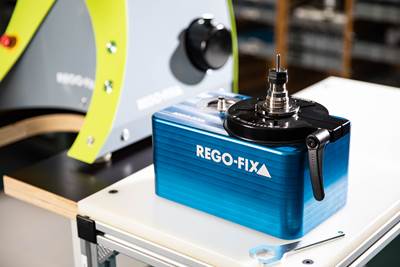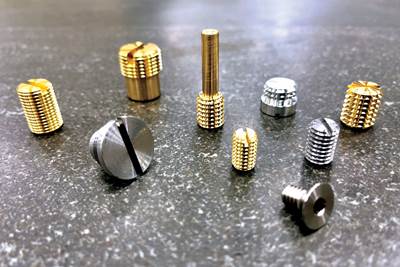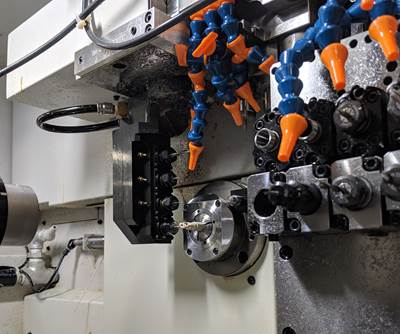Through-Coolant System Cuts Nickel-Alloy Cycle Times by 70%
Decker Machine Works recently adopted Rego-Fix’s reCool through-coolant system for ER collets, reducing the cycle times on a nickel alloy job by 70%.
Share









Autodesk, Inc.
Featured Content
View More.png;maxWidth=45)
DMG MORI - Cincinnati
Featured Content
View More
Noah Decker runs his family’s shop on a single split shift from 6:00 AM to 6:00 PM. The shop used to run a night shift, but he says that between staffing and service difficulties, this type of operation only really works if the shop is at the size and scale that it can afford on-call tech support during the night. Images courtesy of Decker Machine Works.
“If you’re not in the business of innovating and growing, you’re in the business of dying,” says Noah Decker, CEO of Decker Machine Works, a machine shop based in Greenfield, Massachusetts. He also knows just how versatile this innovation and growth can be, from retrofitting older technology to experimenting with newer technologies. For example, a recent adoption of a retrofittable through-coolant system for ER collets from Rego-Fix enabled the shop to boost its spindle speeds on a difficult, high-volume job by 50% while quadrupling tool life and improving surface finish.
Balancing Farm Equipment with Nuclear Fusion
Noah Decker is the second-generation owner of Decker Machine Works, which his father founded in 1982. Noah says he’s worked in the shop since he was a small kid, and bought the company from his father in 2022 after assuming leadership duties in 2020. The shop takes on a wide range of jobs, including high-tolerance components for the aerospace, space exploration, defense and medical industries. At the same time, the shop makes time to serve local customers who may not otherwise have access to nearby job shops with the expertise to develop solutions for their needs. As Noah puts it, sometimes the shop is working on parts for experimental nuclear fusion reactors, other times it’s working on lawnmower housings. About the only thing the shop won’t take on, he says, is ceramics.
With this variety in customers comes a similar variety in part specifications. The shop’s lot sizes range from a single part to 500,000 parts, its part tolerances extend from 0.015 inch to 0.000050 inch and jobs can use anything from PEEK to aluminum to Inconel to pure silver. To meet these requirements, Decker uses nine Citizen Swiss machines, a twin-turret/twin-spindle Eurotech lathe, several CNC mills and lathes, wire forming and wire EDM equipment, and some specialty large-format manual machines for bespoke jobs.
Decker hasn’t just grown with this equipment, however — it has also developed idiosyncratic processes to handle its unique workloads. For example, the shop is not afraid to use the Swiss machines, often prized for their ability to automate high-volume jobs, for jobs that only require a single part. It also sometimes uses its largest Swiss machine, often meant for parts with a maximum diameter of 35 mm, for some jobs that use 38-mm barstock. Noah says that using the machine in this way does introduce a few difficulties and limit the potential maneuvers, but it comes in handy from time to time—especially as this kind of manevuer pushes the skills of Decker’s younger machinists.

Much of Decker’s Swiss machining involves small drilling with diameter-to-depth ratios between 15 × D and 50 × D. This can make coolant delivery especially difficult.
Preservation, Reinvention and the DIY Question
The manual machines Noah grew up using have also found a niche in the shop’s operations. These machines are housed in Decker’s original building, an old mill from the 1880’s that used to operate on hydroelectric power from the river next door. Noah calls this building a “quasi-functioning museum,” taking great care to preserve the old machines. He does so not just to keep the knowledge of historical manufacturing techniques alive, but also to keep track of whether the old machines can be retrofitted, repurposed or used for specialty tasks. For example, one job the shop receives every two years involves stamping an old-fashioned logo for a home cheese-making kit. Using newer machines to create this part would take 20 minutes per engraving as opposed to the three-second cycle times with a 20-ton flywheel punch press.
Retrofitting also enables the shop to be as judicious about its funds as it is creative about its solutions. Noah points to a Nikon microscope that his team recently retrofitted. In its heyday, the microscope used a DRO from the 1980s. After taking it out of storage, his team installed a 1080p display and a three-axis camera with 4k resolution. This boost in specifications has enabled Decker to return the microscope to the lab, all at a fraction of the price of a new microscope.
The shop’s metrology lab also employs nine other Nikon microscopes, plus two Keyence machines, six Brown and Sharpe comparators retrofitted with LED lights (which Noah says are just as good as the old metal-halide bulbs, but much less expensive), a Brown and Sharpe CMM that Decker bought used and then retrofitted, and a new Hexagon CMM. Amidst all the retrofitting, the new machine may stand out, but Noah says it’s all part of the shop’s process. Most of its retrofitting comes down to sustainable growth, he says, and part of that is knowing how to balance the monetary savings of retrofitting versus the time savings and capability increases of purchasing new equipment.
This leads to an interesting mix of old, new and in-house original machining technology around Decker. Its in-house ERP system is built on Excel, having started as a parts counter and evolved from there. A custom, in-house gundrilling system enables the team to use 2000 PSI coolant through the spindle on its Swiss machines. Decker will EDM collets it has bought to retrofit them with through-coolant capability, with coolant supplied by racing break lines on account of their durability.
Moving to Through-Coolant
As with the Hexagon CMM, however, sometimes purchasing specialized equipment wins out over a DIY solution for the shop. For one job, Decker needed to drill a hole 0.043-inch in diameter and 0.740-inch deep — a task with a diameter-to-depth ratio which made most coolant delivery methods extremely unreliable. What’s more, the barstock was a nickel-based alloy with different harmonics from bar to bar, leading the shop to rotate the tool rather than the barstock. While the shop was able to successfully machine the parts and features required, the average cycle time was at 5 minutes and 47 seconds and tool life was at about 250 parts per drill — not particularly efficient for a 20,000-part job.
This changed after a visit from the shop’s Rego-Fix vendor, Carl Haynes, who works with the shop on many of its new workholding and toolholding equipment purchases. Haynes saw the job and immediately suggested using the reCool system, a retrofittable through-coolant system for the company’s ER 11 collets. This system could convert the shop’s flood-coolant driven tools into through-tool-coolant tools, even at their small size.

Once Decker grew familiar with Rego-Fix’s reCool system for ER 11 collets, converting flood-coolant driven tools to through-tool-coolant took all of two minutes.
Converting to a though-tool-coolant system led to more effective thermal control of the cutting zone. This extended tool life up to about 1,000 parts per drill while improving finish and surface control. Noah says the reCool system also helped the shop maintain more consistent hole straightness. This coolant delivery system also improved the spindle speeds Decker could use to run its Swiss machines, from 8,000 rpm to 12,000 rpm. This has reduced cycle times by around 70%, down to 1 minute and 44 seconds per piece. Over the course of 20,000 pieces, this cycle time improvement has had a massive impact on the profitability of the job.
Noah says that the solutions the shop learned from this job — and the reCool system itself — will carry forward to other high-tolerance jobs in the future. The shop will stick with less expensive, “sacrificial” collets for high-wear jobs such as castings that can easily break tools and collets alike, but the Rego-Fix ER collets and reCool system will be in play for critical part processes.
Knowing when to experiment in-house, when to buy new technology and when to accept that a tool only needs to be good enough to handle a high-wear job has been a vital part of Decker Machine Works’ success. Building in-shop familiarity with tools and components has helped its machinists know how to tackle Decker’s wide range of jobs and ensure its growth into the future.
Related Content
Simulation and Tooling Secure High-Value Work
Simulation software and careful attention to tooling parameters have enabled Major Tool to take on ambitious projects with its complex machinery.
Read MoreJergens Pull Studs Enable Quick Changeovers
SP140 and K02 pull studs offer quick-change solutions for vise or gripper jaws, electronic component manufacturing, packaging machines, medical technology and automation.
Read MoreRego-Fix’s Center for Machining Excellence Promotes Collaboration
The new space includes a showroom, office spaces and an auditorium that will enhance its work with its technical partners.
Read MoreHow to Troubleshoot Issues With Tool Life
Diagnosing when a tool is failing is important because it sets an expectation and a benchmark for improvements. Finding out why gives us a clue for how to fix it.
Read MoreRead Next
Five Common Mistakes Shops Make with ER Collets (And How to Prevent Them)
Collets play a crucial role in the machining process, so proper tool assembly and maintenance is important. Here are five potential pitfalls to avoid when using ER collets.
Read MoreHow to Start a Swiss Machining Department From Scratch
When Shamrock Precision needed to cut production time of its bread-and-butter parts in half, it turned to a new type of machine tool and a new CAD/CAM system. Here’s how the company succeeded despite the newness of it all.
Read MoreWhen a Swiss-Type Is a Lathe and a Five-Axis Mill
Swiss-type lathes with a swiveling B axis enable this shop to machine parts complete and unattended that it otherwise couldn’t using its five-axis machining centers. Here is some of what it learned adopting this new technology.
Read More













.png;maxWidth=150)
















.jpg;maxWidth=300;quality=90)





